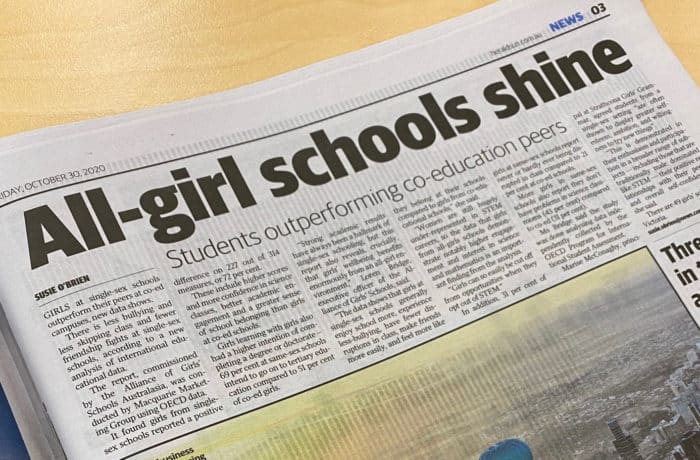In the Media: Herald Sun 30 October 2020, front page and page 3, by Susie O’Brien & Kids News
New data reveals that girls attending single-sex schools outperform those at co-ed institutions.
There is less bullying and less skipping class and fewer friendship fights at single-sex schools, according to a new analysis of international educational data.
The report, commissioned by the Alliance of Girls’ Schools Australasia, was conducted by Macquarie Marketing Group using OECD data.
It found girls from single-sex schools reported a positive difference on 227 out of 314 measures, or 72 per cent.
These include higher scores and more confidence in science classes, better academic engagement and a greater sense of school belonging than girls at co-ed schools.
Girls learning with girls also a higher intention of completing a degree or doctorate – 69 per cent at same-sex schools intend to go on to tertiary education compared to 51 per cent of co-ed girls.
Students at all-girls schools have a higher intention of completing a degree or doctorate
“Strong academic results have always been a hallmark of single-sex schooling, but this report also reveals, crucially, that girls’ wellbeing benefits enormously from an all-girl environment,” Loren Bridge, executive officer of the Alliance of Girls’ Schools, said.
“The data shows that girls at single-sex schools generally enjoy school more, experience less-bullying, have fewer disruptions in class, make friends more easily, and feel more like they belong at their schools compared to girls from coeducational schools,” she said.
“Women are still hugely under-represented in STEM careers, so the data that girls from all-girls schools demonstrate notably higher engagement and interest in science and mathematics is an important finding from the analysis. Girls can so easily be cut off from opportunities when they opt out of STEM,” Ms Bridge said.


Girls at single sex schools have more confidence in science classes than girls at co-ed schools.
In addition, 31 per cent of girls at same-sex schools report never or hardly ever being disrupted in class compared to 21 per cent at co-ed schools. More girls in same-sex schools also report that they don’t have problems in science classrooms (43 per cent) compared to co-ed (31 per cent).
Ms Bridge said the study was done analysing data independently collected by the OECD Programme for International Student Assessment.
Marise McConaghy, principal at Strathcona Girls’ Grammar, agreed students from a single-sex setting “are often shown to display greater self-esteem, ambition, and willingness to try new things”.
“This is demonstrated in their enthusiasm and participation in a broader range of subjects – including those that are traditionally male dominated like STEM – their positive relationships with their peers, and overall self-confidence,” she said.
There are 49 girls’ schools in Victoria, including a number of government girls’ schools, such as Canterbury Girls’ Secondary College and Pascoe Vale Girls’ College.


